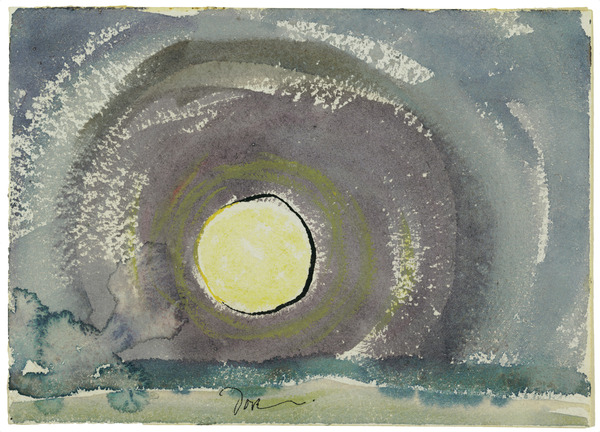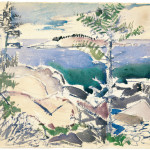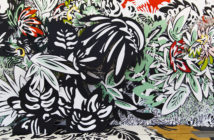By FRANKLIN EINSPRUCH
Over the last twenty-one months, Bostonians have been putting an unusual amount of thought into the state of their art world, wondering aloud how we might make this a better place for visual art: more exhibitions, more media coverage, more collectors, more regional representation in the museums reflected in both the staff and the holdings.* The variety of opinions offered reflects the multifarious nature of the problem: what would it look like to have engaged institutions, active collectors, and a thrilling creative atmosphere in a New England city, acknowledging New York while going its own way? As an example thereof, I submit to you "American Moderns on Paper: Masterworks from the Wadsworth Atheneum Museum of Art," currently on display at thePortland Museum of Art through September 12. This outstanding collection came into existence thanks to the combined efforts of gifted art aficionados in and around Hartford. The private collectors cared about what was going on in the museums, the museums cared about what was going on in the private collections, and they both found themselves with first-hand views of the beginnings of several productive movements of American modern art.
The catalog and the exhibition reflect the priorities of two key Atheneum directors. Essays by Elizabeth Mankin Kornhauser and Carol Troyen will delight museum geeks as they describe the ambitions of these men and the lengths to which they went to secure works that they believed best indicated the direction of art. The first is A. Everett "Chick" Austin Jr., a reformer with no patience for all the "historical" work on display at the time of his arrival. In the first year of his appointment he set about collecting all the works on paper by Edward Hopper, Charles Demuth, John Marin, Georgia O'Keefee, and other contemporary artists that he could get his hands on. His successor, Charles C. Cunningham, continued in the same vein, evincing a mystical sensitivity by noticing Charles Burchfield, Arthur Dove, and Morris Graves. A refrain appears, germane to the present, that the directors were able to acquire large numbers of works on paper because of their lower price point and their prior acquisition by astute private collectors. One of those collectors, the architect Philip L. Goodwin, ultimately shaped the Atheneum's collection as much as any director in the museum's history.
Goodwin had a bottomless appetite for Marin that I don't share, but it's to his credit that the several Marins in "American Moderns" are as good as they are. Chief among them is Big Wood Island from 1914, painted on site during his first of many visits to Maine's Casco Bay region. It's less overtly Cubist and consequently gentler than his typical compositions, and his scratchy application in watercolor is confined appropriately to two pine saplings. Goodwin acquired this piece from Alfred Stieglitz's seminal 291 Gallery at the behest of Austin, who found Stieglitz personally intolerable. This gives you an idea of the degree that Austin vested his vision in Goodwin's eye.
Charles Demuth is represented by two groups of watercolors painted ten years apart. The early ones are part of his Eight O'Clock series of men lounging around the domicile. It's difficult to imagine a time when these could have been viewed without a homosexual subtext, but we are assured by the catalog that they were received as evocative, languorous scenes of male camaraderie by luminary collectors. In Eight O'Clock (Morning) from 1917, a blond figure in his whities, as he moves to remove his other shoe, has just caught sight of either the raised behind of his friend leaning over in the bathtub, or the barely noticeable face of a third figure in bed. The effects that Demuth got out of the strange, semi-absorbent paper, with pooling paint and gritty textures, are unlike anything else ever executed in watercolor. A decade later he was working a bit more conventionally, or at least with better materials, but his still lifes lost nothing of their charm and remain some of the medium's masterpieces. His Still Life with Eggplant and Summer Squash from 1927 glows with lucid, restrained beauty. I see in Demuth an exemplar of a light yet powerful touch that must have been dear to Austin, reflected as it is in an elegant geometric nude in black chalk by Isamu Noguchi from 1920, a bowl of grapes by Yasuo Kuniyoshi from 1922, a pastel drawing of a clam shell by O'Keefee from 1926, and a silverpoint study of frangipani by Joseph Stella from around 1920.
Cunningham's curatorial choices are intriguing. Nowadays it is difficult to see much work by Morris Graves outside of the Pacific Northwest (the Seattle Art Museum has excellent holdings), but the artist had an exhibition at the Museum of Modern Art in 1942. A decade later the Atheneum acquired a fine Graves: The Myth of Division and Separation from 1940, in which a black-eyed totemic bird basks in the glow of a white enso, the so-called Zen circle representing the essential unity of all existence. Cunningham also gets credit for the presence of a couple of delightful pastels by the woefully underrated William Baziotes. The better of these,Figure in Foliage from 1954, shows a highly abstracted powder-blue torso doing a little dance on a gently-hued stage, while leaves stretch down from the rafters like the arms of an octopus. Buzzing visionary landscapes by Burchfield fit right in with both of these.
Troyen describes Austin's taste as "modern-but-not-modernist," and Cunningham didn't deviate far from it. Austin mounted one of the first museum shows of surrealism, and his legacy accounts for the fact that abstraction in "American Moderns" tends towards Arshile Gorky, Baziotes, Dove, and David Smith, then proceeds downhill to Matta, Theodore Roszak, Seymour Lipton, and Mark Tobey. This wouldn't be so bad if not for the surfeit of contemporaneous talent of the caliber of Pavel Tchelitchew (although his 1936 Cover for Program for Hartford Festival presages concert posters produced in Providence sixty years later) and flat-out bad calls like the creepy, fey Kristians Tonny. However, these surrealists and semi-surrealists give us the opportunity to consider the social aspect of the art world of Hartford at the time. Museums are sometimes criticized for ancillary programming that doesn't relate to or complement visual art, but the tendency to sponsor it is an old one. Austin mounted the aforementioned Hartford Festival, which featured "concerts, films, vocal performances, and ballets" according to the catalog, reflecting his belief that the Atheneum should serve as "a museum of living things." "American Moderns" also includes festival set designs by Eugene Berman, as well as Tchelitchew's design for the invitation to the Paper Ball, a party thrown by Austin in February 1936 that required guests to don costumes made of disposable materials. Hundreds of people attended and the last of them didn't toddle out of the museum until dawn. Whatever improvements we might make to Boston's art world, I humbly suggest that we at least have more balls.
* For the record, this conversation began in its present form in December 2008 with Matt Nash here at Big Red & Shiny, in an essay lamenting the state of the alternative gallery scene. This prompted Greg Cook, art critic for two Phoenix weeklies and proprietor of the New England Journal of Aesthetic Research, to pen his first Yokelist Manifesto in January 2009. He has issued five more manifestos since then advocating a local-positive approach to collection, curation, staffing, and press coverage. In January and February of this year, Kyle Chayka, picking up from Cook, wrote a three-part series for Hyperallergic which added to these thoughts and solicited input from local art worlders. In March, Dushko Petrovich offered his own manifesto for Boston in the Globe that failed to acknowledge any of this preceding work but did make some original suggestions. I responded to Petrovich's article on my former blog. (back to article)
- Arthur Dove (United States, 1880–1946), Sunrise, 1937, opaque and transparent watercolor, pen and ink on ivory wove watercolor paper, 5 x 7 inches. Wadsworth Atheneum Museum of Art, The Ella Gallup Sumner and Mary Catlin Sumner Collection Fund, 1955.265.
- Edward Hopper (United States, 1882–1967), Methodist Church, Provincetown, 1930, watercolor on paper, 25 x 19 3/4 inches. Wadsworth Atheneum Museum of Art, The Ella Gallup Sumner and Mary Catlin Sumner Collection Fund, 1951.19.
- John Marin (United States, 1870–1953), Big Wood Island, 1914, opaque and transparent watercolor over graphite drawing on ivory paper, 14 1/4 x 16 3/8 inches. Wadsworth Atheneum Museum of Art, The Schnakenberg Fund. 1951.275.
"American Moderns: Masterworks on Paper from the Wadsworth Atheneum Museum of Art" is on view September 12, 2010 at the Portland Museum of Art, located at 7 Congress Square, in Portland, ME.
All images are courtesy of the Portland Art Museum and and the Wadsworth Atheneum Museum of Art.







